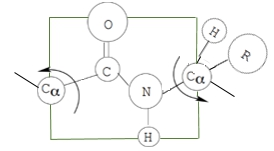So now that we know about the peptide bond and primary protein structure, before we get to secondary protein structure, we're going to talk about the peptide group. Recall that the peptide bond is an amide covalent linkage. The atoms that are around the peptide bond exhibit special characteristics, and these characteristics are critical to the overall shape of a protein. These atoms around the peptide bond are part of the peptide group. The peptide bond is a specific covalent bond, but the peptide group refers to specific atoms surrounding the peptide bond. These specific atoms of the peptide group are the 2 peptide bond atoms, or the 2 atoms that are directly involved in the peptide bond, as well as their 4 neighbors or the 4 atoms to which these 2 atoms are bonded. There's a total of 6 atoms in the peptide group. These 6 atoms include the carbonyl group atoms, the amino group atoms, and the 2 adjacent alpha carbons. We'll be able to see this in our example below.
In this example, we're going to consider the peptide group. We will circle all of the alpha carbons and draw the resonance arrows for the bonds of the peptide group. What we have is a dipeptide, having 2 amino acid residues. You can identify this by the 2 R groups, which are in blue. This R group here is just a hydrogen, indicating a glycine residue. The other group, a methyl group, indicates an alanine residue. These two residues are joined by the peptide bond, which is in red. Notice that the atoms in pink are part of the peptide group. The atoms of the peptide group include the carbonyl group, which are these two atoms here, the atoms of the amino group, these 2 atoms here, and the 2 alpha carbons connected to the R groups. There's resonance present between some of these bonds of the peptide group. A lone pair on the nitrogen comes down to the peptide bond, and the double bond on the carbonyl group shifts up to the oxygen. We've included our resonance brackets and arrows here, showing another resonance structure. In this resonance structure, there is a double bond on the peptide bond, and on either side, there is a negative charge on the carbonyl group oxygen and a positive charge on the nitrogen. Across this peptide bond, there's actually a dipole moment, showing it as a polarized peptide bond. Drawing the dipole moment, you can see an electron density shift from the nitrogen to the oxygen, emphasizing the polar nature of the peptide bond. Additionally, it has partial double bond character. The best way to represent resonance is by drawing a hybrid resonance structure. Below, we present the hybrid resonance structure, a more accurate depiction of the resonance occurring. Here, our peptide bond has partial double bond character. Similarly, the carbonyl group double bond and the partial negative charge on the carbonyl oxygen, and a partial positive charge on the amino group nitrogen are highlighted. These features, the polarization of the peptide bond and the double bond character, will be important as we move along. We'll talk more about them throughout our lessons. See you guys in our next practice problem where we will apply some of these concepts.





